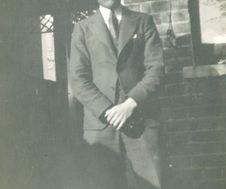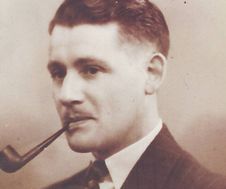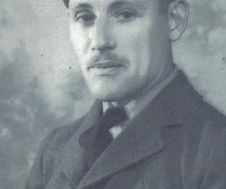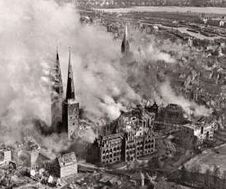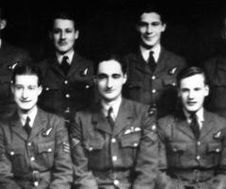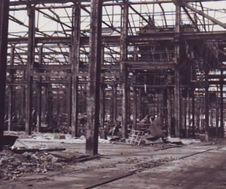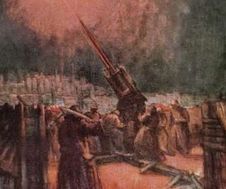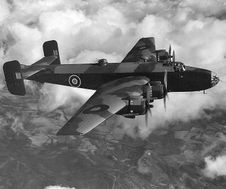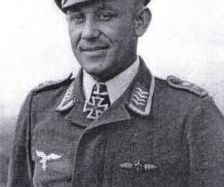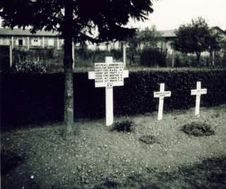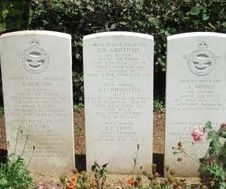Into the Flak
Germany’s air defences were not cheap; vast amounts of wealth, men and materiel was being dedicated to halting the bombers by the second half of 1943. These efforts paid off in the short term, enmeshing Bomber Command in a statistical nightmare: its crews had a 51% chance of being killed on an operation; a 3% chance of being injured; a 12% chance of being captured; a 1% chance of escape; and a 24% chance of making it through unscathed. The remaining 9% were involved crashes over friendly territory, either through pilot error or mechanical fault. The RAF, aircraft manufacturers and some of the brightest minds available tried to improve the odds by introducing new aircraft variants and installing new technologies. This included the development of Gee and Oboe, early targeting devices that used radio waves. There were also electronic jamming kits and an on-board ground-scanning radar, the H2S, although the latter was used with caution as concern grew across autumn 1943 that the night fighters were homing-in on the waves it emitted.*
*In fact, the night fighters only used H2S’s signal as a rough guide to keep track of the bomber stream. The real danger for the bomber crew came from the Monica tail warning radar that acted as a short-range beacon. These problems were fully resolved after July 1944 when a German night fighter became lost and landed at a British airfield by mistake. This allowed the RAF to make thorough checks of the enemy’s technology and determine the latent danger of Monica, the use of which was immediately prohibited.
Other defensive measures included the use of ‘window’, whereby thousands of foil strips were jettisoned from the bombers in the hope of confusing enemy radar operators with the sudden emergence of innumerable blips. It worked well when first used in mid-1943, but the Germans soon adapted and upgraded their technology to cope. Nonetheless, window always made life for the defenders that little bit trickier. Specially-adapted British aircraft with equipment that could interrupt and jam enemy airwaves were also sent over, relaying false orders on German frequencies and hoping to create confusion. Many of the RAF’s own night fighters – usually specially-adapted Mosquito aircraft – were tasked with destroying their German counterparts over the target, although they failed to achieve a large tally of kills. However, it was an additional problem the Luftwaffe now had to worry about.
Bomber strategy evolved as well, with two or three streams often sent out on divergent courses and seemingly aiming for different points on the map. They would then swing onto the primary target at the last possible moment, keeping the Germans guessing where to focus their night fighters and creating an alert across a much broader range, wasting the enemy’s time and sapping his energy. Bomber Command could also use these divergent streams to strike separate objectives if it so wished. Finally, the RAF increased the variety of bombs carried: incendiary bombs; 40lb and 250 lb small bombs; 250 lb and 500 lb medium-capacity bombs (MC); and the 4,000 lb ‘cookie’. The arsenal was expanded in 1944 with the 1,000 lb MC bomb, the 8,000 lb ‘Blockbuster’ High Capacity (HC) bomb and, for the Lancaster only, the 12,000 lb ‘Tallboy’ HC bomb. The 22,000 lb ‘Grand Slam’ was introduced in March 1945 and was the most powerful conventional bomb of the war, needing a specially-adapted Lancaster for delivery.
The men of Bomber Command were well aware of the dangers they faced and the destruction they caused. Indeed, many among them had witnessed and been on the receiving end of the Luftwaffe’s bombing efforts, men just like Ernie. But they sincerely believed their efforts were helping to win the war and bringing about victory in a quicker timeframe.* It is also worth remembering that all of them were volunteers and had the right to walk away if they so wished, although those that did would have the dreaded letters LMF – lacking moral fibre – attached to their name. This was formal recognition that a man left his crewmates behind when needed most and those declared LMF were often given ground duties of no particular importance or shunned entirely.
*See endnote 1 on the debate about the bombing’s efficacy and morality.
Today we might find the concept of LMF deeply unsettling, but we have a far greater understanding of combat psychology/fatigue and the implications of post-traumatic stress disorder, or PTSD. Research in this field was still in its infancy in the early 1940s and not far removed from basic First World War theories about ‘shell shock’, with the medical community still struggling to understand the semi-permanent/permanent mental damage that repeated bouts of life-threatening danger can have. Some men were ‘washed out’ on a doctor’s orders, which carried less stigma as they were often deemed to have kept trying despite their frayed nerves. However, they represented a hazard because all crew members had to be at their best; any human weakness in the air could invite lethal errors and oversights.
Action stations
So what actions did Johnston’s crew take part in? It is impossible to know for sure without Johnny’s logbook. The crew had achieved 26 missions before the night of their deaths and it is almost certain they were involved in the aerial Battle of Berlin. It is also likely that they bombed targets in the Ruhr and perhaps some of the German port cities. Later on, during the build up to D-Day and just afterwards, their missions were dominated by targets in northern France. Their service would not have been continuous as short breaks were sometimes granted after particularly gruelling missions, while formal leave usually stood at one week off for every six weeks on operations. This afforded crews vital time to rest and catch their collective breath. Ernie spent much of his leave back in London, staying with the family, and Heather recalled an occasion when he visited Joan and Les in Shepperton in 1944 with Johnny in tow.
At the National Archives there is a combat report filed by Johnston and the crew’s gunners just after a raid on the Tergnier railway marshalling yards in northern France on 18 April 1944. Their destruction was part of a new phase in the war, in which Allied Command wanted to disrupt and destroy the enemy’s ability to move or supply units via rail. The Germans were well aware of the shift in the RAF’s focus and had bolstered their defensive presence in the region by moving in extra detachments from various night fighter and flak units. Using this mission as a template, and combining it with other sources, it is possible to determine what it might have been like for the men of Aircraft O.
Johnny’s crew would have reported for duty after breakfast and, in this instance, been told a raid was highly likely. Behind the scenes, the target’s details had already been phoned and wired through to the 76 Squadron’s intelligence officer, and it was his job to start planning with other senior personnel. This included determining weather conditions, bomb load and flight plans. Liaison then built up between the various squadrons in 4 Group, while contact was also maintained with Bomber Command headquarters. As the plans were being finalised, 76 Squadron crews visited their aircraft to check and double-check their machines with ground personnel. The bombs and fuel were added at this time as well.
The men then congregated for a late-afternoon assembly in the briefing room, with the intelligence officer, base engineering officer, flying control officer and a weather expert seconded from the Metrological Office already present. The station and squadron commanders arrived shortly afterwards, and a large map outlining the flight route and target details would be unveiled. Splashes of red cellophane cut-outs indicated zones of flak and defence – a line going through one of these innocuous-looking splodges could mean destruction and death when airborne.
There was not much by way flak coverage for Tergnier, although it was known the enemy’s night fighter coverage of northern France was growing. The crews were dismissed after a short question and answer session, with the pilots heading to the stores to collect their maps on which they marked up the flight path. The navigator also familiarised himself with the route, while the flight engineer made assessments with regards to range, fuel load and expected fuel usage. Wireless operators took ‘flimisies’ on which the necessary radio frequencies for the night were printed. Crews then gathered in the locker room, hauling on their flying clothes and equipment, and getting bussed to their aircraft once ready.
Having made a number of final checks of personal equipment, the crew of Aircraft O clambered aboard. Once settled in and ready, Ernie checked the fuel gauges and gave Johnny clearance to start up the engines. This done, their Halifax taxied to the runway and waited for take-off at its allotted time. Ernie kept his eyes on the engineer’s panel, making sure the dials were responding properly, while the air bomber, Gilbert Griffiths, went forward to assist the pilot with take-off. Aircraft O then lumbered down the runway and heaved itself into the air. Johnny and Harold Earl, the navigator, soon discussed course settings via the intercom in order to reach 4 Group’s assembly point at the right time and place. Dotted across the night sky would have been the twinkling navigation lights of the other bombers as the stream formed up. These were switched off when the mass turned south, using designated air corridors and flying at a cruising speed of around 200 mph.
The crew switched to oxygen masks at about 5,000 ft, while the gunners Moult and Stoke asked to test fire their weapons when the aircraft was roughly ten minutes away from the enemy coast. This done, they started scanning the night sky for prowling night fighters. Ernie continued to keep an eye on the fuel status, oil temperatures and pressures, while Earl eventually told Johnny to set a new course: one that took Aircraft O to the target. Pathfinder aircraft had already dropped coloured flares to mark the way as the bombers neared their goal and, as expected, the flak was especially light when compared with that over Germany. Searchlights were also noted as absent on this mission, which would have been a welcome relief.
Griffiths now relocated to a special bay under the pilot’s cockpit to prepare for the run-in, while Ernie moved into the cockpit bulkhead to check the master fuel cocks as Johnny would have wanted to know how much fuel was in the tanks. This could be especially important if Griffiths failed to sight the target and called for another run-in, something crews loathed because it left the aircraft exposed, out of formation and using up precious fuel. However, it was a necessary evil because each aircraft needed to drop its bombs on target for the mission to count towards the crew’s overall tally.
Fortunately, the weather conditions above Tergnier were fine and Griffiths soon had the bomb bay open, squinting through the bombsight and waiting for his target vectors to line up. The aircraft was now flown straight and level, with Griffiths instructing Johnny on the final approach, calling out for an increment to the right or the left. Happy with the aircraft’s position, he then pressed the release button and called ‘Bombs gone!’ Johnny had to hold the aircraft steady for around 30 seconds as a flash photo of their location was needed to confirm they were on target and that the mission was undertaken. Aircraft O then banked away and started a return journey that was much easier compared with flying back from Germany. However, the crew remained alert and, peering through the gloom, Griffiths suddenly noticed an enemy Ju 88 on the port beam, between 200 and 300 yards away. He shouted out a warning and Stoke, the mid-turret gunner, responded by swinging his Brownings towards the threat and blasting off about 50 rounds, possibly damaging their opponent who was seen to dive away.
Not taking any chances, Johnny slammed the Halifax into a corkscrew manoeuvre. Nerves strained, the aircraft was soon back at operational height, the pilot asking Earl to tell him co-ordinates for a new flight path. Soon over British skies, the crew relaxed a little and, approaching their home region, they kept their eyes out for the Pundit Beacon flashing a Morse signal to identify 76 Squadron's station, Holme-on-Spalding Moor. Closing in, Johnny obtained landing permission from the control tower and brought Aircraft O home. The men would have been exhausted as they clambered down and boarded a bus that took them to the debriefing room, and one can easily imagine them discussing Stoke firing his guns and praising Griffiths for his sharp eyes. There would have also been the unspoken joy of seeing another dawn.
As a married man, Ernie had a more stable domestic life than most of his young crewmates. Billie had moved up from London and the two of them rented a property in Market Weighton, a small village near Holme-on-Spalding Moor. After gruelling missions and hair-raising episodes like the encounter with Ju 88, Ernie must have found life rather schizophrenic. One minute he was flying into a night filled with death and destruction, the next he was back with the person he loved the most. Lieutenant John Stene, RNAF, remembered the strange duality of serving in Bomber Command, writing: ‘[There was an] incredible contrast between war and peace. I remember so often when waking up from a few hours’ sleep after returning from a trip; I felt that the night’s action might just as well have taken place in a dream.’
Out of time
May and early June 1944 saw Bomber Command’s campaign over northern France reach a crescendo, particularly in the immediate weeks following the capture of beachheads in Normandy after D-Day on 6 June. Amiens railway station was an important target because it acted as a main junction for the Calais-to-Paris and Rouen-to-Paris lines, making it the central switching point for rail traffic between the Pays de Calais region and Normandy. Hitler and many in his staff thought Pay du Calais, not Normandy, was the most likely place for Allied landings and so had stationed the bulk of Germany’s anti-invasion reserves there. In realisation of their error, they were now rushing reinforcements towards the Allied beachheads, particularly via Amiens.*
*Primarily at night as movement during the day was made extremely dangerous by Allied fighter-bombers and medium bombers.
Reports filed at the National Archives suggest the damage to Amiens junction was fairly comprehensive by D-Day, although one or two lines were noted as still viable. Longueau, a village just southeast of the town,* had a junction that was vital to the smooth running of Amiens and this had escaped the attention of Bomber Command or the American daylight bombing fleets of the USAAF. It was decided the RAF would attack Longueau junction on the night of 12/13 June to further disrupt Amiens’ operability, the target’s importance underlined by the use of almost 200 bombers to ensure its obliteration. Ernie’s squadron contributed 22 bombers that night, with the first taking off at 21:57 and the last at 22:22. The flying conditions were described in the 76 Squadron’s logbook as ideal.
*Now almost a suburb of Amiens.
Under the Master Bomber’s guidance, the stream dropped its ordinance on the target from a height of 10,000 ft. The log noted: ‘Several enemy aircraft were seen in the vicinity of the target and on the route back.’ This observation was confirmed by 578 Squadron’s log, although it added something else: ‘The defences en route were more active than usual. Enemy aircraft were also more active… 12 aircraft were reported shot down and seen to go down in flames.’* With bombs dropped, the stream left the target area. The log for 76 Squadron recorded 21 aircraft returned and three notable events: Aircraft Q was attacked and escaped; Aircraft Y was damaged by friendly fire and crash-landed back in England; Aircraft O was reported as missing. It is worth noting here that Stoke, the regular gunner, was not on board that night and his place was taken by Douglas Burton. How this would have affected Aircraft O’s performance would only be conjecture, although crews were sometimes wary about having a new person on board, especially if they were inexperienced or an unknown entity.
*If 578’s log is correct, then the Longueau raid was a bad one for Bomber Command. A loss of 12 aircraft equates to 6% of the attack force for a mission just over the English Channel and without searchlights or heavy flak. It even compares badly with the 5.4% average loss rate per mission during the grim aerial Battle of Berlin (although this campaign achieved some truly eye-watering percentage losses, such as 9.1% on the final sortie on 24 March 1944).
Johnston’s crew probably reached and bombed the target because their crash site was some distance west of Longueau, suggesting Aircraft O was preparing to start its run back over the English Channel. Perhaps their Monica tail warning radar had given them away, or maybe they had been struggling at this stage and slipped out of the bomber stream, presenting a good target. Possibly it was just their bad luck to have been the one singled out from the mass. Whatever happened, an enemy night fighter had closed on Aircraft O and their opponent just happened to be one of the Luftwaffe's best: Reinhard Kollak, serving with Nachtjagdgeschwader 4. He ended the war with 49 victories and was a holder of the Knight’s Cross.
Flying a Me110, Kollak might have positioned his aircraft under the bomber’s blind spot and used an upward-facing, rearwards-firing cannon located in the middle of the fuselage to make the kill. In order to aim, the night fighter pilot would use a kind of upwards-facing periscope, called a ‘Revi’ reflector site. If the enemy pilot was particularly good, he would aim for the fuel tanks, spelling instant doom for the bomber and giving the night fighter a better chance to dive safely away. Expert flying skills were needed in order for this technique, called Schräge Musik,* to work. But if Aircraft O was in trouble before he went in for the kill, then Kollak could have flown under the bomber’s tail and used the Me110’s forward-facing cannons to destroy the rear-gunner’s position. This done, he would have blasted away at the bomber’s fuselage. Whatever happened that night, there was little Johnny and the crew could have done once the bullets started flying.
*Slanting music or jazz.
The lost and the found
Out of control and plunging through the darkness, the remains of Halifax LW644 tumbled towards French soil. Some of the villagers of Authieux-Ratiéville may well have heard the crash, with the local authorities investigating the site and recovering any bodies at first light. Johnny and his crew had paid the supreme sacrifice – there were no survivors. Back in Britain, two telegrams went out to inform Billie and Ernie’s mother Katie that he was missing, with a strong underlying message that he was presumed killed in action. However, his death was unconfirmed and this offered a glimmer of hope the family clung to in a bid to avoid the grim truth: Ernie was gone forever.
Family letters reflected the desperation, particularly those from Ernie’s brothers Victor and Wilfred. They attempted to offer words of encouragement to Katie, with Victor writing: ‘There is a very good chance he landed and perhaps been taken prisoner, in which case it may be some weeks before we hear, so just do not take it too bad for a while. He has just got to be O.K.’ Wilfred also thought Ernie might have survived and been captured. He added: ‘What can one say at a time like this, but to hope for the best and keep your chin up. If he is a prisoner of war, you won’t have the suspense of him being on ops in the future, and he will be out of this bloody war until it’s finished.’ Ernie’s aunt Norah wrote: ‘We are all very distressed and grieved to hear that news of dear old Ernie and can only pray to God that he landed safely somewhere and will come home eventually.’
Billie – not knowing the facts, other than the telegram’s sketchy details – tried to uncover more information about the fatal mission on the following day. Writing to Katie and Joan, she correctly informed them that one of the gunners had been replaced and that she was also praying Ernie had survived, possibly trying to reach Allied lines in Normandy. Interestingly, someone in 76 Squadron appears to have taken pity on her because she identifies target details, facts that should have remained confidential until news was released through formal channels. ‘It was a French target: Amiens, I think. If he had a chance to bail out it should not be so bad and maybe he will be able to get to our lines – I hope so with all my heart... It just doesn’t seem possible to realise it yet, although I have been expecting it all along, but as he had done quite a few “ops” I had, I suppose, a false sense of security and had begun to look forward to the day he would be “screened” (finished his number for a while).’*
*See endnote 2.
With Ernie snatched away from her, Billie was left wondering what to do next. She continued: ‘I suppose I shall return to London… I am loath to leave the place that has so many contacts… maybe I’ll stay a week or so just to see if any more news comes through, although I shall be very lonely I expect, but it would be just the same in London and I don’t feel like job hunting yet but, on the other hand, I must have something to occupy my mind.’ Billie later joined the Red Cross, thinking she could get a posting to northwest Europe and, when on leave, have the opportunity to travel to Amiens and start asking questions. But it was not to be: she was posted to the Far East instead. Billie never knew the mission’s particulars or what really had happened to Ernie until I presented the findings of this research to her more than 60 years later.
The family believed Ernie was unaware of his promotion to pilot officer and that he had gone on his last mission believing he was still a flight sergeant. This assumption was wrong as Ernie’s promotion to pilot officer came into effect on 4 June 1944, eight days before his death, and he would have been well aware of it. He was being rewarded for good and reliable service – and for survival against the odds. The promotion would have also reflected Johnny’s view of Ernie, as the skipper’s opinion of fellow crewmates informed the RAF on whether a promotion was deserved. Perhaps Ernie was too busy to write home with the news during those hectic days before and just after D-Day, or perhaps he wanted to surprise everyone with news of the promotion after his 30 missions. Regardless, the family only became aware of his new rank through the RAF’s post-crash correspondence.
With the Allies fighting hard into Germany until the war’s end, the task of finding bodies/remains and having them properly buried with semi-formal grave markers was not a top priority. In addition, many temporary resting places only came to light once the French authorities had notified the British, and it was then a laborious process to register bodies/remains for later burial in war cemeteries. Official confirmation of Ernie’s death came almost a year after the crash in May 1945, with the RAF informing the family that the grave of Harold Earl had been positively identified. They were told Earl had been buried in ‘Bose la Hard’ – actually Bosc la Hard – a village close to the crash site, adding that further efforts to discover more were underway.
We shall never know the precise whereabouts of the crew’s remains from when the local French authorities buried the crew to the time when the War Graves Department officially registered and reburied them in Beauvais. It is likely they lay in Bosc le Hard’s village cemetery, which contains the graves of two Scottish infantrymen killed in 1940. The crew of Halifax LW644 were finally laid to rest in the Marissel French National Cemetery, Beauvais, by 1946. Reunited in death, they are buried in collective grave 258. Ernie had spoken to Billie about starting a new life together in New Zealand after the war and, given the devastation he had witnessed and inflicted, who could have blamed him? But it was not to be.
The final say I will leave to an opponent. Ex-night fighter Peter Spoden spent much time reflecting on the war, his role in it, and the progress between the European nations since. In his correspondence to the author, he wrote: ‘I am very sorry for your great uncle Ernie who was in the best time of his life, like so many of his young comrades. Presently we have had no war for 60 years in the EU – the longest time for centuries. Let’s keep it this way for the sake of our children and grandchildren.’ Words Ernie and the rest of Aircraft O's crew would have whole-heartily agreed with.
***
Endnote 1: Many of those who question bombing efficacy often cite Third Reich statistics on rising war materiel output, particularly across 1944 when the bombing was reached its peak. However, this argument conveniently forgets distortions and outright lies by the apparatchiks in charge of production and reporting upwards. In addition, German weaponry and munitions faced longer lead times because of dislocated productivity and the damaged infrastructure. Thus it was one thing to make a tank’s components, for example, but quite another to put them together and then deliver the completed machine to where it was needed most. Of equal importance, this tank required a constant supply of petrol that had to be sourced, processed* and then supplied along the same disrupted logistics chains.
*Made difficult because the USAAF’s increasingly-efficient targeting of refinery operations and the eventual loss of Axis oilfields.
Opponents of bombing also discount the relocation and consumption of German resources in creating and maintaining the Third Reich’s aerial defences. At its peak, Germany had approximately 2,100 AA batteries, or around 10,000 guns dedicated to protecting its airspace. In addition, there were thousands of aircraft and night fighters, hundreds of listening posts, radio and radar relays, and all the ancillary staff this required. The outcome of the war might have been very different had this vast expenditure in German wealth, time and manpower been projected towards the frontlines against the USSR or Western Allies.
Whether area bombing was morally right is another matter entirely. Some argue it should have never been undertaken at all, while others counter that every available measure was required in fighting a regime as brutal as Hitler’s. In the long run, they add, far more lives would have been lost if Germany had maintained its infrastructure unmolested and been able to prosecute its war for even longer. This includes the lives of hundreds of thousands of men, women and children who only just managed to crawl away from the horrific concentration camp system in the war’s final months.
But even if one subscribes to this argument, there is this critical question to consider: at what point did the effective disruption of the German war machine through bombing no longer assist the final outcome and end date? Opponents of bombing argue the campaigns should have certainly ceased by the start of 1945, when it was clear Germany was on the brink of defeat and that the damage inflicted had fulfilled the criteria of area bombing theory i.e. the irrevocable disruption of an enemy’s ability to wage war. Thus they view late-war operations, including the destruction of Dresden and the large-scale loss of life there in mid-February 1945, as deeply problematic. These arguments and the weighty questions that surround them will undoubtedly be debated for many decades to come.
Endnote 2: Billie was referring to the rotation system the RAF ran for bomber crews. A crew would be stood down from frontline duties after 30 missions and the men often sent out as instructors to pass on their knowledge to crews in training. They would be brought back together after six months and begin another tour of 30 missions. Ernie had completed 26 missions before his death and, had he survived, would have returned to the bombers in the closing months of the war. Germany’s defences had been battered and bruised by early 1945 to the extent that, while still dangerous, they were nothing like as deadly as they had been.
Selected bibliography
Baker, R, and editors of Time-Life Books, The RAF at War, Time Life, 2003
Chorley, W R, To See Dawn Breaking, Compaid Graphics, 1996
Deighton, L, Bomber, Harper Collins, 2009
Delve, K, Bomber Command: 1936-1968, Pen & Sword, 2005
Falconer, J, Bomber Command Handbook, Sutton Publishing, 2003
Lewis, B, Aircrew, Cassel, 2003
Price, A, Nuremburg, War Monthly (Issue 25) 1979
Neillands, R, The Bomber War, John Murray, 2004
Norris, John, 88mm Flak 18/36/37/41 and Pak 43 1036-1945, Osprey, 2002
Schneer, J, The Thames, Abacus, 2006
Spoden, P, Ich war Nachtjager in Gorings Luftwaffe, Detlef Monch Druck, Essen,2002
Taylor, J, and Davidson, M, Bomber Crew, Hodder and Stoughton, 2004
National Archives:
Air 27/652
Air 50/193
Air 40/1041
Air 40/127
MOD:
Personal records of Ernest Frederick Lewis
Internet (in no particular order)
www.bbc.co.uk/dna/ww2
www.cwgc.org
www.constable.ca/halifax.htm
www.halifaxbomber.com
www.rafmuseum.org.uk/handley-page-halifax-ii.htm
www.raf.mod.uk
www.revi.cz/images/covers/52/kollak.xls
http://mysite.wanadoo-members.co.uk/archie_bombercommand/1048tls_continued.html
Click below to view gallery: pictures of Ernie; Billie; Aachen burning after a bombing raid; the crew of Aircraft O (with Trott first on left standing, Ernie second on left standing, Earl first on left seated and Johnny middle seated); Essen bombed; painting of an 88mm in action; a Halifax Mk III; Reinhard Kollak; the original grave; and the grave today.
